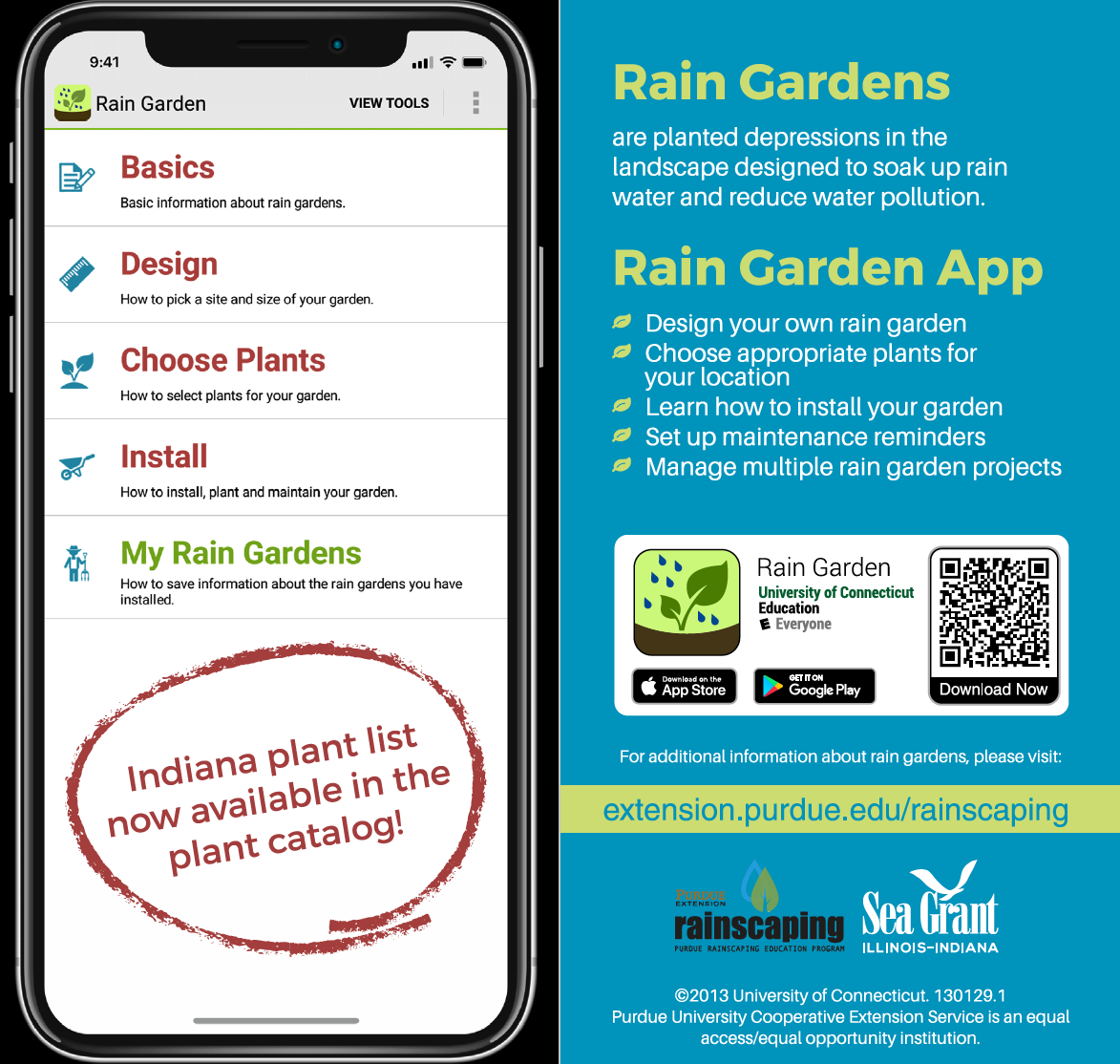August 20th, 2018 by IISG
A smartphone app named “Rain Garden,” designed to help people plan and build rain gardens across America, is now customized with a specialized list of plants suited for Indiana. Through video tutorials, diagrams and tools, the app makes it easy to learn the basics of designing, installing and maintaining a rain garden.
Many people and communities use sustainable landscape design and management practices, such as rain gardens, to prevent polluted stormwater runoff from flowing into nearby rivers and streams and harming the water supply. To stop runoff from reaching water bodies, stormwater can be directed toward rain gardens to be absorbed by plants and soils.

Hoosiers can download “Rain Garden” for free through the Apple or Google app store. Created at the University of Connecticut, the app includes tools for determining soil type, measuring the area needed for the garden, and managing multiple rain garden projects.
The Indiana plant list was made possible by Kara Salazar of Illinois-Indiana Sea Grant and the Purdue Rainscaping Education Program, Rosie Lerner of Purdue Horticulture and Landscape Architecture, John Orick of the Purdue Master Gardener program, Kris Medic of the Purdue Extension Community Development program, Jane Frankenberger of Purdue Agricultural and Biological Engineering, and Laura Esman of Purdue Forestry and Natural Resources.
April 5th, 2016 by IISG
University of Illinois PhD students Pongsakorn “Tum” Suppakittpaisarn, pictured above on the right, and Fatemeh Saeidi-Rizi, pictured above on the left, study rain gardens—but not in the way you’d expect. Instead of measuring infiltration rates and pollution reduction capacity, Tum and Fatemeh want to know what happens in our brains and bodies when we see this green infrastructure practice.
A growing number of studies draw connections between access to green spaces and our physical and mental health. But, Tum said, most of that work has revolved around larger, more ubiquitous landscapes like public parks and tree-lined streets.
“We know green spaces generally are good for mental health,” he said. “But the ‘how’ and ‘why’ is still unclear, especially with rarer landscape types like rain gardens.”
So Tum and Fatemeh, along with collaborators at the University of Illinois’ Sustainability and Human Health Lab and the Health People-Health Landscape Lab at National Taiwan University, are working together to measure physical responses and changes in brain activity triggered by images of rain gardens.
The team has compiled 216 rain garden photos taken across the U.S. into nine different videos. In Illinois, Tum will use biofeedback sensors to measure what happens to participant heart rates, body temperatures, and more when they see these videos.

At the same time, Dr. Chun-Yen Chang’s team in Taiwan will use functional magnetic resonance imaging—better known as fMRI—to monitor and map changes in brain blood flow when participants are shown rain garden photos after being put through a series of tests designed to cause mental fatigue.
The researchers only began testing participants this spring, but they have a few predictions about the final results.
“It’s possible that seeing rain gardens in an urban space will help people recover from mental fatigue faster,” said Tum. “On the other hand, rain gardens with a lot of messy plants may make people feel uncomfortable, which may lead to them feeling more stress or mentally fatigue.”
October 20th, 2015 by iisg_superadmin
Next summer, a parking lot on an Indiana campus will be a little prettier and a little less likely to flood due to a recently installed rain garden. That rain garden planting capped off a training workshop at Indiana University-Purdue University Columbus (IUPUC).
The Purdue University Extension Rainscaping Education Program team held a two-day intensive workshop September 17-18 for 24 participants from across the state, including Master Gardeners, Soil and Water Conservation District professionals, landscaping contractors, and municipal separate storm sewer system managers.
They learned specifics about rain gardens and other rainscaping techniques, which offer an alternative to standard infrastructure methods for flood prevention and stormwater management. These plantings capture rain water where it lands and slowly absorb it into the soil.
The goal is for workshop participants to take this new knowledge back home to incorporate rainscaping in their community, to engage in public education, and to provide technical assistance. “In Jasper County, participants who attended our previous workshop have held sessions for residents based on our program,” said Kara Salazar, IISG specialist. “Several participants from this workshop have already expressed plans to do the same.”
 The workshop was designed to use flipped class instruction, which means the participants came to class already knowing the ABCs of rain gardens. Before the workshop they had homework, which was to watch seven instructional videos. “This approach really worked,” said Salazar. “We were able to go in depth in our classroom discussions.”
The workshop was designed to use flipped class instruction, which means the participants came to class already knowing the ABCs of rain gardens. Before the workshop they had homework, which was to watch seven instructional videos. “This approach really worked,” said Salazar. “We were able to go in depth in our classroom discussions.”
The workshop included a tour of rain gardens in the area and hands-on experience helping with the installation of the IUPUC rain garden. This garden was an opportunity to also bring in IUPUC students, who participated in the site selection and the planting. They will also work with faculty member Luke Jacobus, rainscaping team member Kris Medic, local Master Gardeners, and the campus maintenance crew to help maintain the garden.
“As we choose a host site for our demonstration gardens, longevity and sustainability are key factors,” said Salazar.




